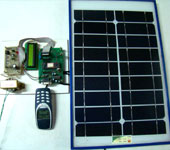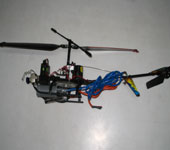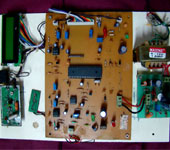GSM Based Home Security System Synopsis/ Abstract
GSM Based Home Security System
Abstract
Home security has been a major issue where crime is increasing and everybody wants to take proper measures to prevent intrusion. In addition there was a need to automate home so that user can take advantage of the technological advancement in such a way that a person getting off the office does not get melted with the hot climate.
Introduction
The project is aimed at developing the security of Home against Intruders , Gas Leak and Fire . In any of the above three cases any one met while you are out of your home than the device sends SMS to the emergency no provided to it.
The report consists of a background into the area of 8051 microcontroller and mobile communication, how they are interfaced to each other and AT (Attention) commands set used in communication.
HARDWARE USED
1. AT command supporting GSM mobile phone.
2. 89S52 Microcontroller
3. Max 232 IC.
4. Relays
5. Relay driver IC ULN 2803
6. Voltage regulator 7805.
7. Diode IN4007
8. GSM Phone
9. LPG Gas Sensor
SOFTWARE USED
1. Keil u-Vision 3.0
Keil Software is used provide you with software development tools for 8051 based microcontrollers. With the Keil tools, you can generate embedded applications for virtually every 8051 derivative. The supported microcontrollers are listed in the µ-vision
2. PRO51 Programmer Software
THEORY OF OPERATION
BUY THIS PROJECT
Email Freshersblog@gmail.com
Visit Us at – www.IndianEngineer.tk http://www.IndianEngineer.in http://www.Blog.indianengineer.in
WIRELESS MESSAGING VIA MOBILE/LANDLINE
Project Descreption
The main objective of this system is to transmit message or text through ordinary Land Line Telephone/mobile from one end (source) to another end (designation). This is get achieved by the DTMF technology. It has two sections one for editing the text and to transmit the edited text and the other section consist for receiving the text message. The system works on the DTMF technology. (Dual Tone Multiple Frequency).
It involves several steps. They are
DTMF decoding/Encoding process
Ring sensing
ON/OFF hook detection
Displaying the message in LCD
The above process is get achieved by the microcontroller AT89S8252/AT89C51/52.Thus Microcontroller controls the whole system.
As the title “wireless messaging via mobile/landline phone” itself indicates that this project deals with the transfer of message from one mobile to another or one landline to another without using wire connection.
The DTMF tones sensing circuit display the message at LCD as sent by other end by means of tone transmission.
Applications: DEFENCE, FUN & ENTERTAINMENT, GAMES & SPORTS, SURVILLANCE
Project Title: MICROCONTROLLER AT-89S8252 BASED WIRELESS MESSAGING VIA MOBILE/LANDLINE PHONE (SMS) Category B. TECH PROJECTS ENGINERING DIPLOMA Technologies Used: MICROCONTROLLER (EMBEDDED) BASED Subjects: ELECTRONICS & COMMUNICATION, ELECTRONICS & ELECTRICALS, HOBBY KITS ELECTRONIC HOBBY KITS Modules Used: DTMF ENCODER/DECODER , REGULATED POWER SUPPLY Call Us Now! to Book This Project +91-9530670077,09868816785
Mail Us at Freshersblog@gmail.com
MICROCONTROLLER AT-89S8252 BASED WIRELESS MESSAGING VIA MOBILE/LANDLINE PHONE (SMS)
Microcontroller Based Projects
Microcontroller Based Projects
- WIRELESS MESSAGING VIA MOBILE/LANDLINE
- GSM BASE HOME SECUIRTY SYSTEM
- GSM BASED HOMEAUTOMATION & SECUIRTY
- AUTOMATIC TOLL TAX
- VOTING MACHINE
- SMS BASE DEVICE SWITCH
- SOLAR TARKER SYSTEM
- TEXT DATA COMMUNICATION THROUGH FIBER/LAGER
- DIGITAL COMBINETION LOCK
- SAFETY GUARD FOR THE BLIND (PROXIMITY BASE
- SMS THROUGH TELEPHONE
- SPEED CHECKER FOR HIGHWAYS
- SMART CARD
- DATA SECUIRTY SYSTEM
- TOUCH SCREEN
- HEART BEAT MONITOR
- AUTOMATIC ROOM LIGHT CONTROLLER:
- RADAR SYSTEM ILIGAL AROPLAN DETECTOR
- PRI-PAID CAR PARKING
- MULI LAVEL CAR PARKING
- FASTEST-FINGER-FIRST USING 89C51
- MICRO PROCESSOR BASED REVERSIBLE D.C. MOTOR CONTROL
- STEPPER MOTOR CONTROL USING 89C51
- MIC-89C51 MONITORING SYSTEM
- MANUAL AT 89C51 PROGRAM
- AT 89C2051 BASED COUNTDOWN TIMER
- MICROCONTROLLER BASED CODE LOCK USING AT 89C2051
- LCD FREQUENCY METER USING 89C2051
- CALLER ID UNIT USING MICRO-CONTROLLER
- MICROPROCESSOR-BASED HOME SECURITY SYSTEM
- STEPPER MOTOR CONTROL USING 89C51 MICRO-CONTROLLER
- MICRO CONTROLLER BASED TEMPERATURE METER
- MICRO CONTROLLER BASED HEARTBEAT MONITOR
- ULTRASONICRANGEFINDER USING PIC MICRO CONTROLLER
- CALLER- ID UNIT USING MICRO CONTROLLER
- MICRO CONTROLLER BASED PATHFINDER
- MICRO CONTROLLER BASED ROBOT.
- MICRO CONTROLLER MOVING MESSAGE DISPLAY
- MICRO CONTROLLER BASED RELAY SWITCHING
- MICRO CONTROLLER AUTO DIALER USING GSM.
- MICRO CONTROLLER BASED WATER LEVER INDICATOR
- MICRO CONTROLLER BASED WIRELESS HOME AUTOMATION
- MICROCONTROLLER BASED RADAR SYSTEM
- MULTI CHANNEL INFRA RED CONTROL 4 different point 89c2051 micro controller in transmitter and receiver, using infra red technique.
- MOVING MESSAGE DISPLAY : 89c51 micro controller Led matrix,
- Digital clock with alarm: using 89c51 micro controller
- TRAFFIC LIGHT WITH DOWN COUNTER : all the four sides of the road with one side counter display using 89c51 micro controller circuit.
- ULTRASONIC DISTANCE METER USING MICROCONTROLLER
- PRI-PAID CAR PARKING SYSTEM
- MICRO CONTROLLER TEMPERATUIRE METER
- ANOLOG TO DIGITAL CONERTER USING AT89C51 MCU
- INFARED REMOTE CONTROLE SYSTEM
- ULTRASONIC MOVEMENT DETECTOR
- MICROCONTROLLER BASED TACHOMETER
- MCU BASED VISITOR COUNTER
- PWM CONTROL OF DC MOTOR USING 89C51
- AN INTELLIGENT AMBULANCE CAR WHICH CONTROL TO TRAFFIC LIGHT
- PRE-PAID ENERGY METER
- MICROC CONTROLLER BASED LINE FOLLOWER OR TRACING ROBOT
- AUTOMATED WALKING ROBOT CONTROLLED BY MCU
- AUTO BRAKING SYSTEM
- AUTOMATIC RAILWAY CROSSING GATE CONTROLLER
- CELL PHONE OPERATED LAND ROVER PROJECT
Subscribe here for free SMS updates on ur Mobile
microcontroller and microprocessor, microprocessor questions, microprocessor book 8085 microprocessor architecture, types of microprocessor microprocesor programs, 8086,8085,atmel microcontroller,arduino microcontroller, arduino,8051 microcontroller pdf,arm microcontroller,microcontroller based project,microprocessor based projects,embedded systems,pic projects, pic microcontroller projects,microcontroller pic,programming microcontroller ,microcontroler projects, avr microcontroller,avr,atmel micro controllermicrocontroller and microprocessor, microprocessor questions, microprocessor book 8085 microprocessor architecture, types of microprocessor microprocesor programs, 8086,8085,atmel microcontroller,arduino microcontroller, arduino,8051 microcontroller pdf,arm microcontroller,microcontroller based project,microprocessor based projects,embedded systems,pic projects, pic microcontroller projects,microcontroller pic,programming microcontroller ,microcontroler projects, avr microcontroller,avr,atmel micro controller
Microcontrollers & Use in Embedded Technology
Its fun programming and working with microcontrollers. With microcontrollers you can create a piece of hardware which acts according to your wish (obviously with some limitations !). Examples are you can flash a LED, drive a 7 segment display, print text on a LCD, receive signals from a remote control, control electrical appliances of your room, build a robot that follows a line on the floor and avoids obstacles coming in between, frequency meter and infinitely many more..
Basically a Microcontroller is a mini computer with CPU, Memory, I/O lines etc. Microcontrollers are much better for smaller embedded systems than their ancestors i.e. microprocessors, if you are developing a system using microprocessor, then your hardware or circuit will be more complex whereas if you choose a microcontroller, your hardware becomes simple because all the necessary peripherals such as RAM, ROM, TIMERS, I/O ports etc are embedded in a microcontroller. Therefore it is also called a mini computer on a chip. Now we will start with interfacing various devices to microcontrollers (Assuming you have basic knowledge of 8051 architecture and assembly programming and also C). I have chosen 8051 microcontroller due to its simplicity in architecture and assembly language, and learning 8051 chip is much easier than other microcontrollers if you don’t have any prior knowledge on microcontrollers. For more detailed information of hardware architecture and assembly language of 8051 microcontroller you can refer hardware manual and instruction set from ATMEL’s homepage.
Most of the projects and tutorials published here are based on Atmel’s AT89S52 microcontroller, it is a 8- bit microcontroller with 8051 architecture, comes in a 40 pin DIP, contains all necessary peripherals required for a hobby project. Now for a microcontroller to be operational the minimum hardware you need is a crystal oscillator, power supply, power on reset etc. So I have come up with a very simple development board to carry on the projects and interfacing tutorials published here. (Note: This development board is not compulsory; you can also rig up the circuits in breadboard since most of the circuits are simple). You can construct the development board on a general purpose circuit board. (Soon I will be publishing PCB layout for this).
We will start with interfacing microcontroller with LED’s, Displays, Motors, Relays etc.
· Interfacing 7 segment Display
· Interfacing multiple 7 segment displays
· many more to come…
In order set up your simple home lab, you need
· keil or any other assembler/compiler.
· ISP programmer circuit
· ISP programmer software
· Target hardware (your development board or circuit).
Microcontroller 7 Segment Interfacing
Seven segment display is a basic type of display which can display numbers from 0 to 9. The circuit for interfacing single 7 segment display is shown below.
Driving a 7 segment display is as simple as flashing LEDs, but here we are flashing 7+1 LEDs. The 7 segment display module has 8 LEDs (7 segments to display number and one segment for decimal point or dot) arranged in a particular manner as shown in image below.
By driving (in the sense controlling ON and OFF conditions) these LEDs in various combinations, we can display the numbers 0 to 9. There are basically two types of 7 segment displays, they are common cathode and common anode. In common cathode, the cathodes of all the LED segments are connected together, we should apply a logic 1 or high input to a segment pin to light up that particular segment, and in common cathode the case is opposite. Table below shows the combinations of inputs to be applied to 7 segment display for digits 0 to 9.
| For common cathode displays | ||
| Digit | binary input value | hexadecimal input value |
| 0 | 11111100 | FC |
| 1 | 01100000 | 60 |
| 2 | 11011010 | DA |
| 3 | 11110010 | F2 |
| 4 | 01100110 | 66 |
| 5 | 10110110 | B6 |
| 6 | 10111110 | BE |
| 7 | 11100000 | E0 |
| 8 | 11111110 | FE |
| 9 | 11110110 | F6 |
| For common anode displays | ||
| Digit | binary input value | hexadecimal input value |
| 0 | 00000011 | 03 |
| 1 | 10011111 | 9F |
| 2 | 00100101 | 25 |
| 3 | 00001101 | 0D |
| 4 | 10011001 | 99 |
| 5 | 01001001 | 49 |
| 6 | 01000001 | 41 |
| 7 | 00011111 | 1F |
| 8 | 00000001 | 01 |
| 9 | 00001001 | 09 |
The images shown below are the photographs of 7 segment add-on board for my microcontroller board, I have included one 7 segment in the current version of my development board, so if you are using that circuit then you don’t need an external 7 segment display board. Click on the image to enlarge.
The assembly language source code for interfacing 7 segment display is given below.
| ;************************************************* ; ;Program: Driving seven segment display ;Author: Srikanth ;Website: http://shree-electronics.com/ ;Description: Displays numbers 0 to 9 on ;the LED seven segment display continuously ; ;************************************************* ;Declarations ;************************************************* ;Main program main:mov r0,#08h again:mov port,#11111100b ;’0′ ;************************************************* delay:mov r2,#0ffh ;delay subroutine ;************************************************* end |

















 PROJECTS TO GET COSTLY as demand will increase as exams reach so HURRY to GET it on TIME
PROJECTS TO GET COSTLY as demand will increase as exams reach so HURRY to GET it on TIME





